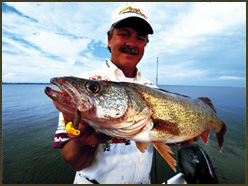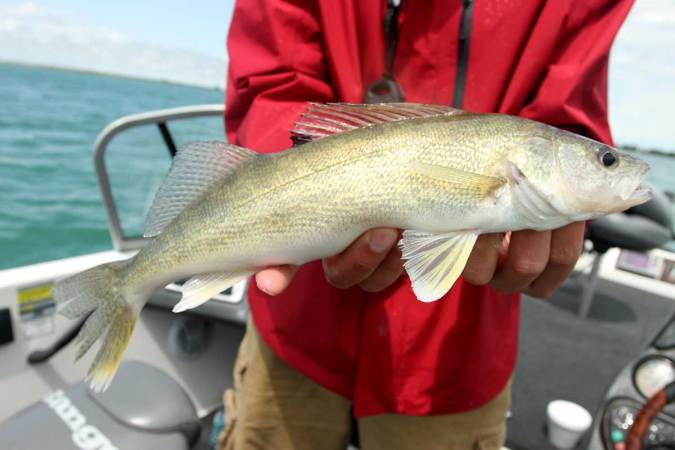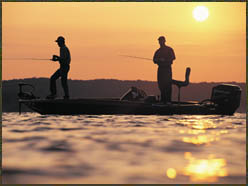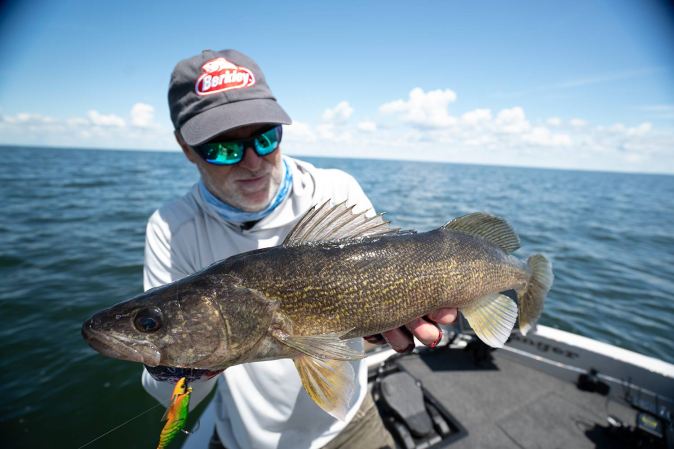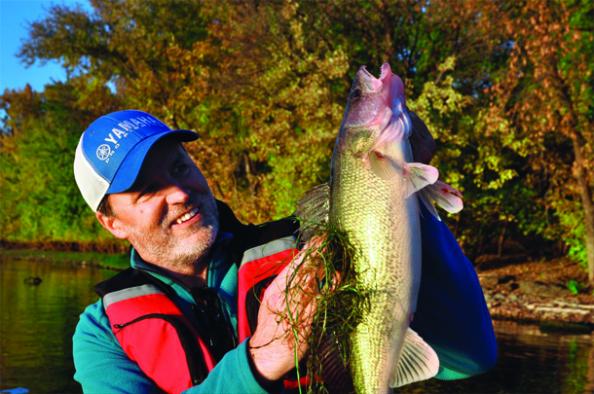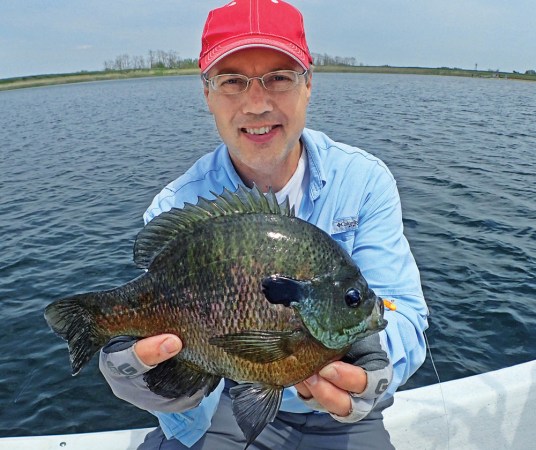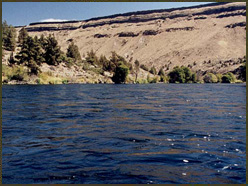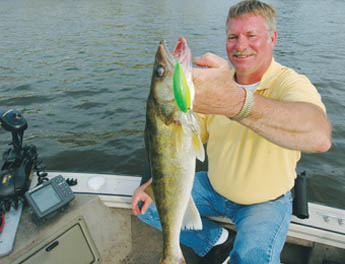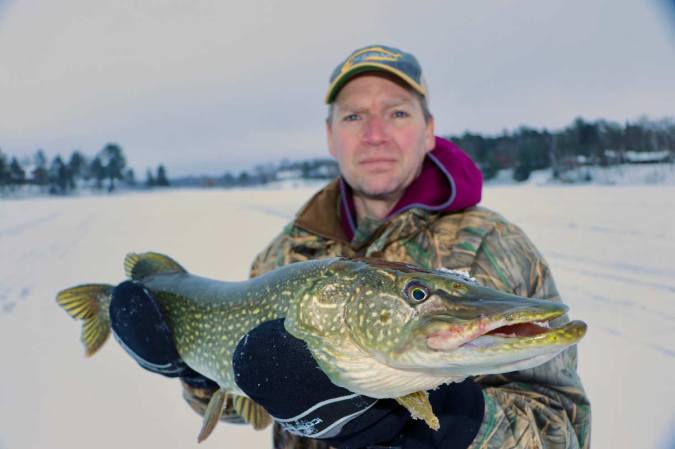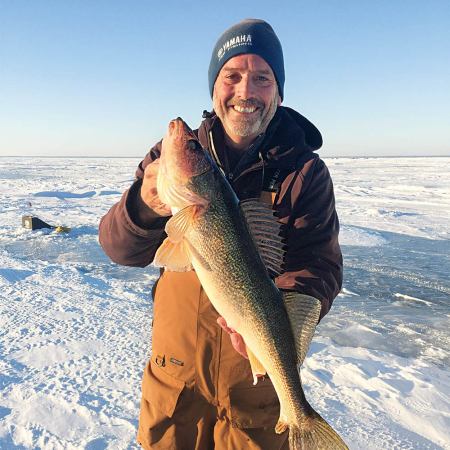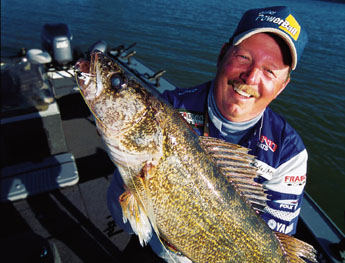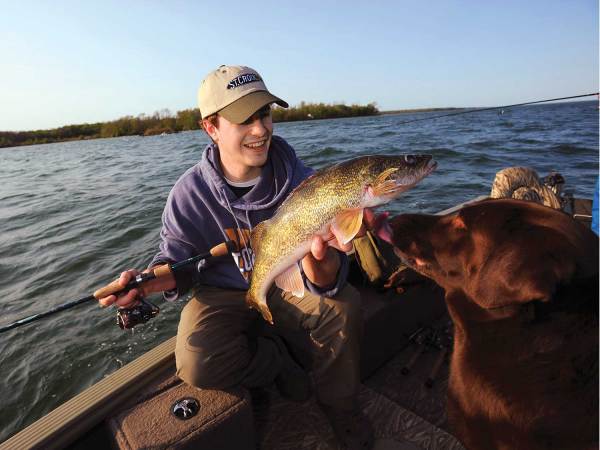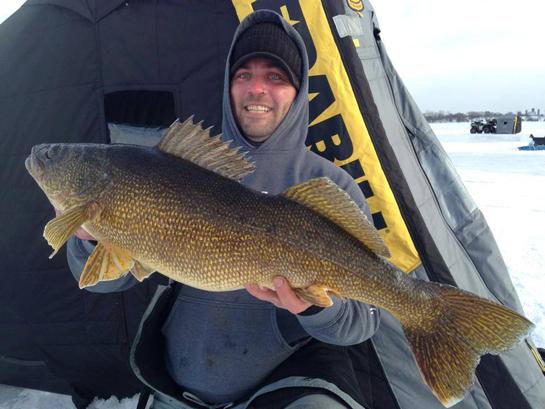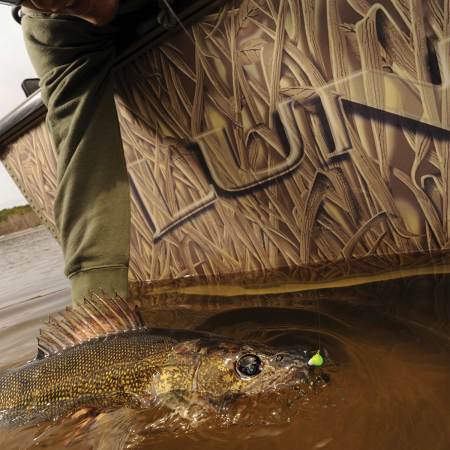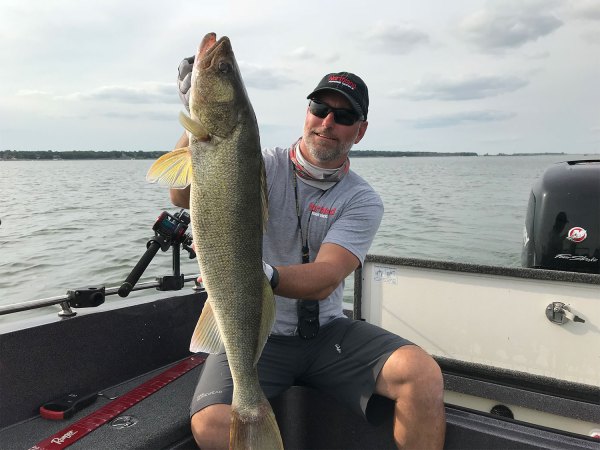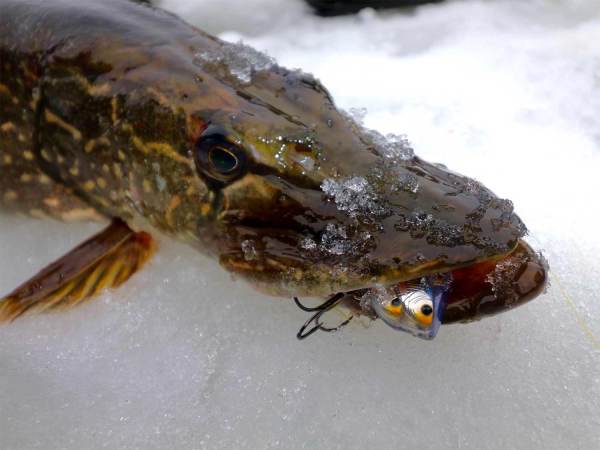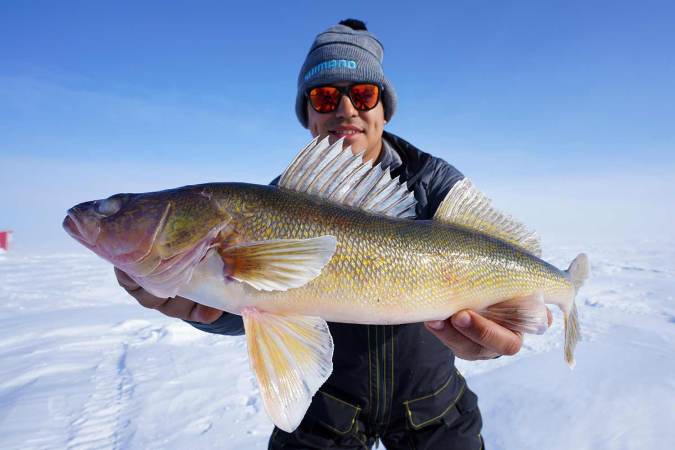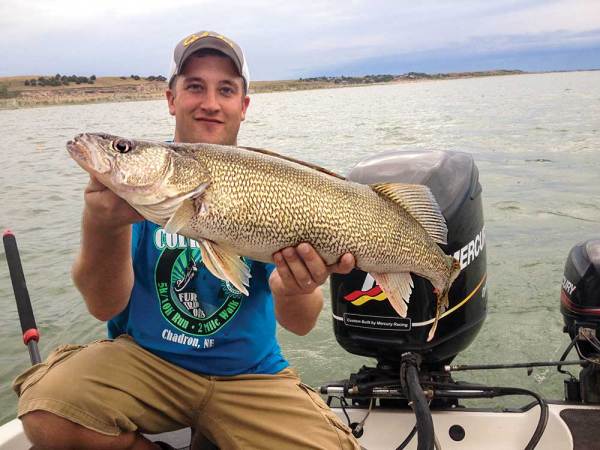Resourceful and ever adaptable, walleyes are where you find them-in brawling current where bottom is littered with slag, bedsprings, TVs and whatnot; throughout wide-open spaces where miles of water stretch in every direction; beneath shallow thickets where a labyrinth of weeds reaches the surface. It’s your job to go there and get them.
Not that any of the above scenarios is easy to master without some ingenuity. That’s where a few professional walleye anglers we contacted figure in. In walleye circles, they’re considered exemplars of innovation and evolution in technique. They’ve laid the groundwork for the rest of us with methods heretofore unthinkable. How about 1-pound weights in big rivers, a salmon-inspired attractor for trolling the Great Lakes and big jigs for puncturing undergrowth àla bass fishing?
You might not have caught wind of what the pros are doing and how they’re doing it yet, but it’s guaranteed you’ll want in on the action. Just remember, you heard it here first.
Daryl Christensen’s Shallow Take on Walleyes
Imagine, if you will, the world’s greatest walleye spots. A sunken island with a pinnacle of rocks? Check. A long point that extends into deep water? You bet. A patch of really thick, nasty weeds in the shallows? Hmmm.
“The truth of the matter is that on most natural lakes, the biting fish are going to be shallow,” says longtime tournament angler Daryl Christensen of Montello, Wisconsin. “For too long the attitude has been that if I’m not catching fish, they’re not biting. What we’ve learned from tournaments is that the fish are always biting somewhere. On any of our lakes all over the continent, if you have weeds and walleyes in the lake, there’s always a group of walleyes in there.”
In a pattern that defies traditional walleye mores, shallow weeds are a dependable location for finding feeding fish. Consider the food-a factor that makes the walleye’s world go round-found in the greenery. Where photosynthesis provides cover and oxygen, minnows, bugs and crayfish abound. The walleyes go there to eat. That’s why it’s possible to pop fish in 5 feet of water on a 100-degree day.
To Christensen, 53, it matters less what kinds of weeds are available than what their depth and makeup are. “My greatest hope,” he says, “is to find weeds, whether they’re milfoil or cabbage, that are in six to seven feet of water, with some that are breaking the surface.” Christensen scans the area for the presence of baitfish: minnows skipping the surface or cruising in clusters.
Fishing weeds, however, demands tenacity and precision. Trolling is almost out of the question, and of course nobody likes to clean junk from lures when casting or jigging. But with an attitude adjustment, it’s possible to pry the walleyes out. “It isn’t really all that hard,” Christensen says. “The bass guys figured it out a long time ago. They go into the worst stuff in the world and yank out five-pounders. You have to do what they do; go with heavy tackle and heavy line.”
Christensen, a jig maestro nonpareil, teams beefed-up rods and lines with leadheads that are a touch heavier. With medium-heavy spinning tackle and 12-pound-test line as a starting point, Christensen knows that aggressive fish will be undeterred by heavy line, even bright-gold line that makes it easy to see when a walleye swims off with a jig. And while it’s tempting to pitch 1/16-ounce pixies with a leech into pockets in the weeds, Christensen kicks it up a notch.
He hooks up with jigs as large as 3/4-ounce and 1-ounce, which he rigs Texas-style with a piece of plastic worm (see diagram below) to puncture the weeds. On the light side, Christensen goes with a Bait Rigs Odd’ball. The Odd’ball has an eyelet positioned more to the front than on top of the jig to shed weeds.
When jigging weeds, Christensen most often chooses natural bait. Muscular enougho deter pecking panfish, leeches are great options around weeds. When crawlers get murdered by bait-stealing munchkins, a soft-plastic worm like a Mann’s Walleye Worm or a Berkley Power Bait is a better choice. Walleyes usually will take a bait on the initial fall. If nothing happens, yo-yo the jig a couple of times, reel it in and pitch into a new pocket.
** Greg Yarbrough at the Pole Position**
In a rip-roaring flow that zips along at 7 mph, one immutable principle prevails: the law of gravity. Using magnum lead that weighs pounds and wire line suitable for saltwater leaders, locals on the Detroit River have long battled the current with handlining rigs (no rods) consisting of spring-loaded reels, window weights and long leaders trailing floating minnowbaits.
Lately a new generation, prompted by tournament rules prohibiting hand-lining, has adapted the method to include rods, reels and places far beyond Motown. Case in point is 34-year-old, Detroit-area pro Greg Yarbrough, who shadowed old-timers in his own boat starting at age 12. When the time came in tournaments to work heavy current or reach deep into still water, Yarbrough broke out more conventional tackle. “I chose a levelwind and a muskie rod,” he says, “and tweaked the setup to make it manageable.”
For the technique dubbed “polelining,” Yarbrough complemented a 61/2-foot muskie rod with heavy-duty terminal tackle to approximate the movements of handlining: touch bottom, lift up, touch bottom again. His choice of line is bright red 80-pound-test Berkley FireLine. “It’s plenty strong and it’s easy to handle,” Yarbrough says. “With lighter line, you’re going to get more wind knots and tangles. You’re almost using small-diameter rope.” To the end of the FireLine, Yarbrough attaches a wire shank equipped with clevises from which he runs 25-pound-test monofilament leaders (see diagram at right). At the bottom of the shank is a weight ranging from 12 ounces to 11/2 pounds, with a pound being the norm.
Length of the leaders is key. Most poleliners, including Yarbrough, run two of them off the shank. A starting point, Yarbrough says, is a 6-foot bottom lead and an 18-foot top lead. “With these leads, if the fish misses the first bait, it’s going to have a shot at the second one. Both lures are going to be running in the range of eight to twelve inches off bottom.”
Another crucial aspect is how you run the boat upstream. Instead of heading straight upriver, Yarbough tacks the current, trolling on an angle with a four-stroke outboard. To keep a bait crossing in front of the fish’s face, it’s best to hold the line angle at 45 degrees. This also helps avoid snags. “You can catch fish going north and south with the current,” Yarbrough says. “But you’ll catch more doing the lateral slide across the current. Don’t watch your speed over ground on a GPS. Barely make forward progress while sliding, quartering upstream a little faster than the current. You’re better off watching the shoreline.”
Yarbrough plies his trade in typical river spots with an assortment of floating baits. Approaching river walleyes with the touch-and-lift action imparted to the baits, Yarbrough works flats, eases up and down ledges and hovers his lures in pools behind bridge pilings. The best baits are floaters that have the buoyancy to work in current without banging bottom. Top choices are Rapala Original Floaters. A smaller one (say, a No. 7) goes on the bottom lead, a larger one (a No. 9) on the top lead. Other options are floating Smithwick Rogues, Reef Runner Little Rippers, baby- and junior-sized Storm ThunderSticks and shallow-diving Rapala Shad Raps. Done right, polelining is applicable year-round on any big rivers such as the Mississippi, in tailraces below dams and even on natural lakes.
Spoonin’ and Spinnin’ With Mark Gwizdala
Improvisation has saved the day for many a walleye angler. Just ask Mark Gwizdala, an inveterate troller on Lake Huron’s Saginaw Bay, who was nonplussed one afternoon during a slow bite on his home waters. That’s when he went rummaging through his tackle and spotted a salmon spoon. The wheels started turning. “I thought, ‘Guys use flashers for salmon and trout; why wouldn’t they work like dodgers for walleyes?'” Gwizdala recalls. “We tried it and, I’m not kidding you, we proceeded to wale on them. The day was like magic.”
Fashioning a bit of tacklebox alchemy, Gwizdala went platinum with a flashy spoon and in-line weight about 6 feet ahead of a spinner with a night crawler. It was a trick that not only changed the way suspended walleyes are trolled on the Great Lakes but also opened the way for the lightweight flutter spoon’s application in other methods of walleye fishing, bottom-bouncing in particular.
“I think the fish see that flash and it gets their attention,” says the 45-year-old Dow Chemical Co. supervisor who fishes the In-Fisherman Professional Walleye Trail. “The next thing they see is that bait go by.”
More than anything, the flasher spoon plays upon the Great Lake walleye’s appetite for attraction. Out on the inland seas, fish weighing from 4 pounds to double digits roam wide expanses, partway down over 20 to 40 feet of water, chasing schools of smelt and alewives. Following the hordes of bait, walleyes put on the feed bag.
When teamed with in-line weights, the spoon rig piques a walleye’s interest and then presents a trolled bait at its level. For the spoon itself, Gwizdala favors a 37/8-incher in silver or gold; another choice of his is a 43/4-incher (see sidebar below). To each end of the spoon, Gwizdala adds a split ring and a ball-bearing swivel to eliminate line twist. Next, an in-line weight of 1 to 3 ounces goes above the spoon. Six feet behind it comes a night crawler harness. Gwizdala opts for sizable No. 5 to No. 8 blades on harnesses tied with 14-pound-test Berkley Trilene XT, a tough, durable monofilament, and one No. 2 single hook in front of two No. 6 round-bend trebles.
Close attention to trolling speed, weight size and distance behind planer boards puts the setup at the desired depth. To make the spoon boogie, Gwizdala insists on speeds of 1.6 to 1.8 mph, faster than the traditional 1-mph range. With a 1-ounce weight 35 feet behind the board, the rig reaches 10 feet. At 60 feet back, it goes down 16 to 18 feet. The same can be accomplished with a 2-ounce weight run 25 feet back from the planer.
An attractor spoon also does the trick on bottom-oriented walleyes. When you spot walleyes pinned to the lake floor on your fish finder, try attaching a smaller spoon of about 21/2 inches to the top arm of a bottom-bouncer. Again, be sure to use ball-bearing swivels, and put the spinner on a 3- to 5-foot leader behind the bouncer. Nogler. Just ask Mark Gwizdala, an inveterate troller on Lake Huron’s Saginaw Bay, who was nonplussed one afternoon during a slow bite on his home waters. That’s when he went rummaging through his tackle and spotted a salmon spoon. The wheels started turning. “I thought, ‘Guys use flashers for salmon and trout; why wouldn’t they work like dodgers for walleyes?'” Gwizdala recalls. “We tried it and, I’m not kidding you, we proceeded to wale on them. The day was like magic.”
Fashioning a bit of tacklebox alchemy, Gwizdala went platinum with a flashy spoon and in-line weight about 6 feet ahead of a spinner with a night crawler. It was a trick that not only changed the way suspended walleyes are trolled on the Great Lakes but also opened the way for the lightweight flutter spoon’s application in other methods of walleye fishing, bottom-bouncing in particular.
“I think the fish see that flash and it gets their attention,” says the 45-year-old Dow Chemical Co. supervisor who fishes the In-Fisherman Professional Walleye Trail. “The next thing they see is that bait go by.”
More than anything, the flasher spoon plays upon the Great Lake walleye’s appetite for attraction. Out on the inland seas, fish weighing from 4 pounds to double digits roam wide expanses, partway down over 20 to 40 feet of water, chasing schools of smelt and alewives. Following the hordes of bait, walleyes put on the feed bag.
When teamed with in-line weights, the spoon rig piques a walleye’s interest and then presents a trolled bait at its level. For the spoon itself, Gwizdala favors a 37/8-incher in silver or gold; another choice of his is a 43/4-incher (see sidebar below). To each end of the spoon, Gwizdala adds a split ring and a ball-bearing swivel to eliminate line twist. Next, an in-line weight of 1 to 3 ounces goes above the spoon. Six feet behind it comes a night crawler harness. Gwizdala opts for sizable No. 5 to No. 8 blades on harnesses tied with 14-pound-test Berkley Trilene XT, a tough, durable monofilament, and one No. 2 single hook in front of two No. 6 round-bend trebles.
Close attention to trolling speed, weight size and distance behind planer boards puts the setup at the desired depth. To make the spoon boogie, Gwizdala insists on speeds of 1.6 to 1.8 mph, faster than the traditional 1-mph range. With a 1-ounce weight 35 feet behind the board, the rig reaches 10 feet. At 60 feet back, it goes down 16 to 18 feet. The same can be accomplished with a 2-ounce weight run 25 feet back from the planer.
An attractor spoon also does the trick on bottom-oriented walleyes. When you spot walleyes pinned to the lake floor on your fish finder, try attaching a smaller spoon of about 21/2 inches to the top arm of a bottom-bouncer. Again, be sure to use ball-bearing swivels, and put the spinner on a 3- to 5-foot leader behind the bouncer. No
